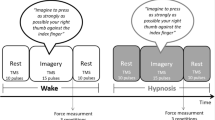Abstract
Changes in muscle electrical activity were studied during local static work until “refusal” under ordinary conditions and during inhibition of the program monitoring functions of the cortex (in the somnambulic stage of hypnosis). The experimental results show that the duration of maintenance of static effort in hypnosis was twice that in the control, and electrical activity of the muscles was increased on the average by 1.5–2 times or, in some experiments, by 3–4 times. In the light of these results the mechanism of formation of “refusal” to work may assume the form of active cessation of activity of the central structures responsible for the program monitoring function.
Similar content being viewed by others
Literature Cited
Yu. V. Moikin, “Methods and importance of investigation of the efficiency of advanced work operations at the bench in mechanical engineering,” Proceedings of a Conference on the Scientific Organization of Work in Industry [in Russian], Sverdlovsk (1958), pp. 77–85.
Yu. V. Moikin, “Methods of investigation of work methods by bench (lathe) operators in industry,” Gig. Truda, No. 4, 39 (1959).
E. V. Montsevichyute-Éringene, “Simplified statistical methods in medical research,” Pat. Fiziol., No. 4, 71 (1964).
A. S. Poberezhskaya, “Electromyographic criteria of fatigue during static effort,” Candidate's Dissertation, Moscow (1970).
D. I. Shatenshtein, Regulation of Physiological Processes during Work [in Russian], Moscow-Leningrad (1939).
R. G. Edwards and O. C. J. Lippold, “The relation between force and integrated electrical activity in fatigued muscle,” J. Physiol. (London),132, 677 (1956).
E. Haas, “Untersuchungen über objektive und subjektive Ermündung bei willkürlichen Kontraktionen,” Pflüg. Arch. ges. Physiol.,218, 381 (1927).
M. Ikai and A. H. Steinhaus, “Some factors modifying the expression of human strength,” J. Appl. Physiol.,16, 157 (1961).
E. S. Roush, “Strength and endurance in waking and hypnotic states,” J. Appl. Physiol.,3, 404 (1951).
Author information
Authors and Affiliations
Additional information
Translated from Byulleten' Éksperimental'noi Biologii i Meditsiny, Vol. 80, No. 8, pp. 12–14, August, 1975.
Rights and permissions
About this article
Cite this article
Moikin, Y.V., Poberezhskaya, A.S. Mechanism of work refusal through fatigue reflected in electromyographic changes under hypnosis. Bull Exp Biol Med 80, 862–864 (1975). https://doi.org/10.1007/BF00789255
Received:
Issue Date:
DOI: https://doi.org/10.1007/BF00789255



